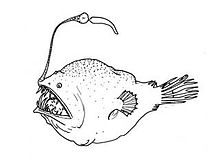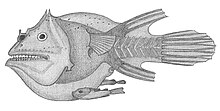Devil angler
| Devil angler | ||||||||||||
|---|---|---|---|---|---|---|---|---|---|---|---|---|

Female Linophryne lucifer from the collection of the Natural History Museum Berlin . |
||||||||||||
| Systematics | ||||||||||||
|
||||||||||||
| Scientific name | ||||||||||||
| Linophrynidae | ||||||||||||
| Regan , 1925 |
The devil anglers (Linophrynidae) are a family of deep-sea frogfish (Ceratioidei). There are 29 species in five genera found in the Atlantic , Indian, and Pacific .
Among the deep-sea frogfish, the devil anglers are considered the most bizarre representatives, have the largest mouths and have particularly long teeth in relation to their body length. In addition to the intricately built esca (the “bait” on the “fishing rod”), which contains symbiotic , bioluminescent bacteria, most female devil anglers have a bioluminescent goatee .
features
The devil anglers differ from all other deep-sea anglers in the small number of fin rays and the Branchiostegalstrahl and the left anus .
- Fin formula : dorsal 3 (rarely 4), anal 3 (rarely 2 or 4), pelvic fins absent.
- Branchiostegal rays: 5 (rarely 4).
female
Metamorphosed females have short, more or less oval or almost round bodies. The length of the head, measured from the tip of the snout to the base of the pectoral fin, is 50 to 60% of the standard length . The snout is relatively short, its length is usually less than 20% of the standard length. The mouth is wide and horizontal or slightly above, the gap in the mouth extends behind the eyes. Both jaws are usually of the same length, the lower jaw protrudes slightly in some species. The mandibular symphysis normally (not wearing a spiked Linophryne -Untergattung Stephanophryne ). The dentition of the individual genera is different. Linophryne , Borophryne and Acentrophryne have a few long teeth, which are arranged in several oblique longitudinal rows. Haplophryne and Photocorynus have shorter teeth, but they are more numerous and are also arranged in several rows. The nostrils sit at the ends of round tubes. The gill cover is divided into two parts, its rear edge is moderately concave. The subopercular is long, extremely slender and without spines or other protrusions on its front edge. The gill cover usually bears one or more spines (spikeless in Acentrophryne ). The skin is flaky and not prickly, the ovaries are paired. Pyloric tubes are missing.
Metamorphosed females have 13 to 19 pectoral fin rays, their caudal fin is supported by a total of nine fin rays (two undivided, four two-part, three undivided). The ninth tail fin ray is very short in Photocorynus and only reaches half the length of the eighth. Epurale (elongated, free-standing bones in the caudal fin skeleton) are usually absent, a single, narrow element is still found in Photocorynus . The posterior edge of the hypuralia is deeply indented (not with Photocorynus ).
The Illicium (the "Angel") is relatively short and in Haplophryne , Photocorynus , Borophryne and various Linophryne species shorter than the diameter of the Esca (the "Bait"), but is 70% of the standard length for Acentrophryne and about 35 to 40 % SL of the standard length for other Linophryne species. The fin-bearer of the Illicium is short and with its front end extends under the skin of the head, sometimes up to the snout region. The Esca is bioluminescent and has no tooth-like outgrowths. A bioluminescent chin barbell (hyoid barbell) is found in Linophryne and is absent from all other genera. The neuromasts of the lateral line system lie at the ends of short papillae.
The color of metamorphosed females is usually dark brown or black with the exception of the esca , hyoid barb and fin rays. Haplophryne is completely colorless. The largest known female of the family is a 23 cm long specimen of Linophryne lucifer , the known maximum length is 15.9 cm for Haplophryne , 10.5 cm for Acentrophryne , 10.1 cm for Borophryne and 6.9 cm for Photocorynus .
Gill arch skeleton
The gill arches consist of four skeletal rods called pharyngo-, epi-, cerato- and hypobranchial from top to bottom. The pharyngobranchial I (uppermost bone of the first gill arch ) is usually absent (only rudimentary in Photocorynus ); Pharyngobranchial II and III are well developed and dentate, Pharyngobranchial IV is absent. The epibranchial I (second bone from above of the first branchial arch) stands free and is not connected to the throat by connective tissue. It is well developed in Photocorynus and Haplophryne and somewhat reduced in Linophryne and Borophryne . The Epibranchialia I to IV are closely connected. The section of ceratobranchiale I near the body is connected to the pharynx, the distal end is free and is also not connected to ceratobranchiale II. The quarter of the ceratobranchial II to IV close to the body are closely connected by connective tissue. The Ceratobranchiale V is usually absent (a small rudiment is still present in Photocorynus ). Ossified hypobranchial cells are also absent, only a single one is present in Photocorynus . Ossified basibranchials (bones at the base of the branchial arches) may be present or absent.
Epibranchial and ceratobranchial teeth are missing. Gill trap rays are found along the entire length of the Ceratobranchiale II, the distal three quarters of the Ceratobranchiale III and the distal half of the fourth Ceratobranchiale. Pseudobranchs are missing.
Dwarf male
The males of the devil anglers are obligatory sex parasites. With the exception of Acentrophryne , both free-living and parasitic dwarf males are known of all other genera. Metamorphosed males have relatively large (6 to 9% of the standard length ), tubular eyes pointing forward, large olfactory organs and clearly separated front nostrils that are more or less directed forward. The males of Photocorynus and Haplophryne have jaw teeth, Borophryne and Linophryne are toothless. The teeth are short and blunt, 3 to 7 are in a longitudinal row in the upper jaw, 2 to 13 in the lower jaw. The fin formula corresponds to that of metamorphosed females. All males lack the hyoid barb. Your skin is bare and without skin spines.
Free swimming males of Linophryne are dark brown or black, those of the other four genera are unpigmented. The firmly grown dwarf males are dark brown or black in Linophryne and Borophryne , colorless in Photocorynus and Haplophryne . The largest known free-living male of Photocorynus spiniceps was 9.8 mm long, while free-living males of the other genera were 15 to 19.5 mm in length. The largest known parasitic dwarf males are 7.3 mm for Photocorynus , 15 mm for Haplophryne , 22 mm for Borophryne and 30 mm for Linophryne . From Acentrophryne no males have so far been caught. In parasitic dwarf males, the teeth, olfactory organs and eyes are more or less regressed. Your stomach is very bloated.
Larvae
The larvae of the devil anglers differ from those of most other deep-sea anglerfish in their elongated shape. Your head is generally 45% of the standard length. They are largely pigmentless or only colored on the sides of the body, never on the back. The skin is loose. The pectoral fins are small and do not extend beyond the dorsal and anal fin. Ventral fins are missing. The number of fin rays corresponds to that of metamorphosed females. Even in the larval stage, the devil anglers show a clear sexual dimorphism. Female larvae have a distinct Illicium approach. The genus Linophryne shows a wart-like thickening at the point where the hyoid barbel grows later. In the largest known female larvae of the genus Linophryne , a rudimentary hyoid barb is already recognizable. In some species, the larvae can be 17.5 to 22 mm long. Metamorphosing animals are 15 to 32 mm long.
External system
Within the eleven families of deep-sea frogfish, the devil anglers are the sister group of the Thaumatichthyidae . The following cladogram shows the probable relationships:
| Deep sea frogfish |
|
|||||||||||||||||||||||||||
|
|
Internal system
The family consists of five genera, two of which are monotypical, i.e. contain only one species, while two others consist of two species and the species-rich genus Linophryne has 24 species, which are divided into three subgenera.
-
Acentrophryne
- Acentrophryne dolichonema Pietsch & Shimazaki, 2005 .
- Acentrophryne longidens Regan , 1926 .
-
Borophryne
- Borophryne apogon Regan, 1925 .
-
Haplophryne
- Haplophryne mollis ( Brauer , 1902) .
- Haplophryne triregium Whitley & Phillipps, 1939 .
-
Linophryne
- Linophryne algibarbata Waterman, 1939 .
- Linophryne andersoni Gon, 1992 .
- Linophryne arborifera Regan, 1925 .
- Linophryne arcturi ( Beebe , 1926) .
- Linophryne argyresca Regan & Trewavas, 1932 .
- Linophryne bicornis Parr, 1927 .
- Linophryne bipennata Bertelsen, 1982 .
- Linophryne brevibarbata Beebe, 1932 .
- Linophryne coronata Parr, 1927 .
- Linophryne densiramus Imai, 1941 .
- Linophryne digitopogon Balushkin & Trunov, 1988 .
- Linophryne escaramosa Bertelsen, 1982 .
- Linophryne indica (Brauer, 1902) .
- Linophryne lucifer Collett, 1886 .
- Linophryne macrodon Regan, 1925 .
- Linophryne maderensis Maul, 1961 .
- Linophryne parini Bertelsen, 1980 .
- Linophryne pennibarbata Bertelsen, 1980 .
- Linophryne polypogonic Regan, 1925 .
- Linophryne quinqueramosa Beebe & Crane, 1947 .
- Linophryne racemifera Regan & Trewavas, 1932 .
- Linophryne sexfilis Bertelsen, 1973 .
- Linophryne trewavasae Bertelsen, 1978 .
-
Photocorynus
- Photocorynus spiniceps Regan, 1925 .
The relationship between the individual genera is illustrated by the following cladogram:
| Linophrynidae |
|
||||||||||||||||||||||||
|
|
swell
Most of the information in this article comes from the web site of the frogfish expert Theodore W. Pietsch at the Tree of Life Web Project . In addition, the following sources were used:
- Kurt Fiedler: Textbook of Special Zoology, Volume II, Part 2: Fish , Gustav Fischer Verlag, Jena 1991, ISBN 3-334-00339-6
- Joseph S. Nelson : Fishes of the World , John Wiley & Sons, 2006, ISBN 0-471-25031-7
- Theodore W. Pietsch: Oceanic Anglerfishes: Extraordinary Diversity in the Deep Sea. University of California Press, ISBN 0-5202-5542-9
Individual evidence
- ↑ Masaki Miya, Theodore W Pietsch, James W Orr, Rachel J Arnold, Takashi P Satoh, Andrew M Shedlock, Hsuan-Ching Ho, Mitsuomi Shimazaki, Mamoru Yabe & Mutsumi Nishida: Evolutionary history of anglerfishes (Teleostei: Lophiiformes): a mitogenomic perspective. BMC Evolutionary Biology, 10 (1), p.58, Feb 2010 doi : 10.1186 / 1471-2148-10-58
Web links
- Devil angler on Fishbase.org (English)
- Pietsch, Theodore W. 2007: Linophrynidae. Sinistral Seadevils Version October 02, 2007, in The Tree of Life Web Project.








